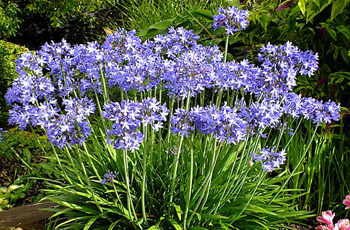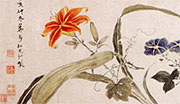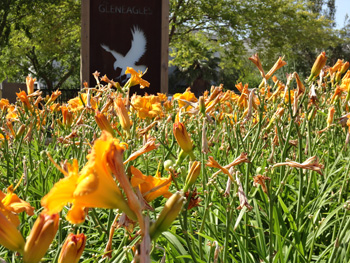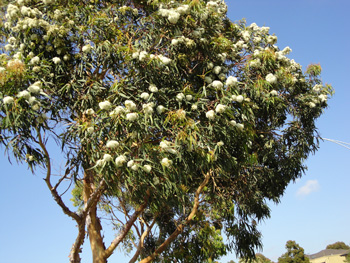Tom Parkinson's monthly column, introducing the diverse range of flora and fauna on show at Sanctuary Lakes.
A couple of months ago we looked at three plants that had migrated to Sanctuary Lakes without the help of human hands; plants that are sometimes cruelly named weeds. Seeing as we are in the middle of the flowering seasons, I thought we could look at flora that were planted by the human hand. Previously we discussed some of the Boulevard's flora, particularly the White Carpet Rose (Rosa Noaschnee) which had a sensational bloom this October / November along the Boulevard intersections and the Wild Iris (Dietes Grandiflora) which are still bursting in and out of bloom. Other carpet roses that have had an intense flowering this season are the crimson and pink roses.
 Lily of the Nile (Agaphanthus) This time we could look at three flora that in time might become Sanctuary Lakes’ spring and summer stand outs. They are the Lily of the Nile (Agapanthus), Daylilies (Hemerocallis) and the Apple Myrtle (Angophora Costata) trees.
Lily of the Nile (Agaphanthus) This time we could look at three flora that in time might become Sanctuary Lakes’ spring and summer stand outs. They are the Lily of the Nile (Agapanthus), Daylilies (Hemerocallis) and the Apple Myrtle (Angophora Costata) trees.
There’s nothing quite as evocative of summer as a row of agapanthus in full flower. Once again Sanctuary Lakes’ Boulevards have wonderful summer displays of bold clumps of Agaphantha blooming their intense blue flowers. Although now naturalised Australians, they were originally a South African species. The name comes form the Greek words, agape being love and anthos being flower.
Agaphantha grow in tight groups, their leaves are basal and curved and grow up to 60 cm long. The flower stalks reach a height of one to one and a half metres tall with large funnel-shaped flowers, in hues of blue to purple, shading to white. Although our flowers are in the main blue purple, there are the occasional white and pink blooms giving a colour variety to some of the larger clumps. Although the thick stems and long-lasting flower attract numerous birds, strangely the seeds are not propagated by them. Instead, seeds fall around the clump and have a tendency to drift downhill which also allows the plant to divide itself.
Agaphantha are a very successful species, so much so that if you speak to a bush regenerator on the Mornington Peninsula or in the Blue Mountains, or even to a ranger in New Zealand's South Island, and you'll hear Agaphantha called an invasive weed. Gardeners and nurserymen, however, tell a different story. For them, Lily of the Nile Agapanthus is a tough, beautiful, long-flowering plant. I am with the Gardeners.
At the entrance of Gleneagles off the North Boulevard is a magnificent glorious orange expanse of Day Lilly (Hemerocallis). They are called Day Lilly simply because individual flowers come out in the morning and are usually gone by the end of the day. Gleneagles’ beautiful hybrids are derived from Daylily species that are native to eastern China which have been cultivated and used in China since ancient times.
 Classic Chinese painting of a Day Lilly Thousand-year-old Chinese paintings show Daylilies with flowers very similar to those of in Gleneagles. Flowers of this type also feature as decorative motifs on porcelain. In China, Daylilies have long been used as herbs. You just put the Daylily under your pillow, or use a pillowslip embroidered with a Daylily, and you will forget your sorrows. The Chinese also believed that women who wore Daylilies in their girdles would conceive sons.
Classic Chinese painting of a Day Lilly Thousand-year-old Chinese paintings show Daylilies with flowers very similar to those of in Gleneagles. Flowers of this type also feature as decorative motifs on porcelain. In China, Daylilies have long been used as herbs. You just put the Daylily under your pillow, or use a pillowslip embroidered with a Daylily, and you will forget your sorrows. The Chinese also believed that women who wore Daylilies in their girdles would conceive sons.
The brownish yellow flower buds of the orange Daylily are dried and used as a food and a medicine. They are sold in large quantities in Chinese food markets, where they are known as flower vegetable or yellow flower vegetable. When cooked, they have a sweetish taste and a moist, soft, gelatinous texture.
 Day Lilies amass at the entrance to Gleneagles Most kinds of Daylilies occur as clumps, each of which has leaves, a crown, flowers and roots. The long, linear lanceolate leaves are grouped into opposite fans with arching leaves. The crown is the small white portion between the leaves and the roots. A proliferation forms roots when planted and is often an exact clone of its parent plant. Daylilies have thickened roots in which they store food and water.
Day Lilies amass at the entrance to Gleneagles Most kinds of Daylilies occur as clumps, each of which has leaves, a crown, flowers and roots. The long, linear lanceolate leaves are grouped into opposite fans with arching leaves. The crown is the small white portion between the leaves and the roots. A proliferation forms roots when planted and is often an exact clone of its parent plant. Daylilies have thickened roots in which they store food and water.
A normal, single daylily flower has three petals and three sepals, collectively called tepals. The centremost part of the flower, called the throat, usually is of a different colour than the more distal areas of the tepals. Each flower usually has six stamens, each with a two-lobed anther. After successful pollination, a flower forms a capsule (often erroneously called a pod). Even though Daylilies produce magnificent coloured flowers and attract many insects and birds, they now reproduce almost solely by underground runners.
The Daylily is often called "the perfect perennial, due to its brilliant colours, generally low maintenance, ability to tolerate drought and to thrive in Melbourne's many different climate changes. It is a vigorous perennial that lasts for many years in a garden, with very little care and adapts to many different soil and light conditions. The Gleneagles Daylily entrance is a terrific eye-catching floral addition to our Boulevards.
 Apple Myrtle Rose Gum flowering along the Boulevards The third Flower is different, it is a tree, that we see planted along the footpaths of the Boulevard; the smooth-barked Apple Myrtle (Angophora Costata) also known as the Rose Gum. We discussed these trees earlier in a piece on the Boulevards, but I am sure you have noticed that over the past few weeks some of these Apple Myrtle Rose Gums are starting to burst forth with a sensational white blossom. The flowers themselves are small no more than 2cm, but they grow together in large clumps of showy white bunches, sometimes covering the whole tree. As our Apple Myrtles Rose Gums are still young we are only seeing a sample of the blossoms that will bloom on the trees in a few years’ time. Hopefully when all the trees start blossoming along the Boulevard they could become a magnificent floral symbol for a Sanctuary Lakes Christmas.
Apple Myrtle Rose Gum flowering along the Boulevards The third Flower is different, it is a tree, that we see planted along the footpaths of the Boulevard; the smooth-barked Apple Myrtle (Angophora Costata) also known as the Rose Gum. We discussed these trees earlier in a piece on the Boulevards, but I am sure you have noticed that over the past few weeks some of these Apple Myrtle Rose Gums are starting to burst forth with a sensational white blossom. The flowers themselves are small no more than 2cm, but they grow together in large clumps of showy white bunches, sometimes covering the whole tree. As our Apple Myrtles Rose Gums are still young we are only seeing a sample of the blossoms that will bloom on the trees in a few years’ time. Hopefully when all the trees start blossoming along the Boulevard they could become a magnificent floral symbol for a Sanctuary Lakes Christmas.
As this is the final Nature's Rubik for 2015, I would like to on behalf of all Sanctuary Lakes residents thank Greg Fryer and his team of gardeners for their great work this year keeping the Resort in absolutely wonderful condition.